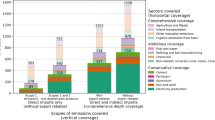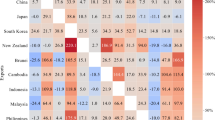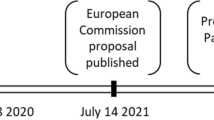Abstract
Harmonized carbon pricing across borders is hard to achieve in the real world as carbon leakage can reduce the cost-effectiveness of unilateral approaches to reduce global emissions. To address this problem, border carbon adjustments (BCAs) would apply the domestic carbon price to emissions embodied in traded goods, which levels the playing field for emissions-intensive and trade-exposed industries. Here, we review the potential environmental and economic impact of border carbon adjustments on leakage reduction, competitiveness restoration, cost-effectiveness, equity and cooperation enhancement. We find that the viability of border carbon adjustment schemes can be substantially reduced with the current legal and practical implementation constraints.
This is a preview of subscription content, access via your institution
Access options
Access Nature and 54 other Nature Portfolio journals
Get Nature+, our best-value online-access subscription
$29.99 / 30 days
cancel any time
Subscribe to this journal
Receive 12 print issues and online access
$209.00 per year
only $17.42 per issue
Buy this article
- Purchase on Springer Link
- Instant access to full article PDF
Prices may be subject to local taxes which are calculated during checkout




Similar content being viewed by others
Change history
31 January 2022
A Correction to this paper has been published: https://doi.org/10.1038/s41558-022-01300-0
References
Vrontisi, Z. et al. Enhancing global climate policy ambition towards a 1.5 °C stabilization: a short-term multi-model assessment. Environ. Res. Lett. 13, 044039 (2018).
Pearce, D. The role of carbon taxes in adjusting to global warming. Econ. J. 101, 938–948 (1991).
Weyant, J. Costs of reducing global carbon emissions. J. Econ. Perspect. 7, 27–46 (1993).
State and Trends of Carbon Pricing 2020 (World Bank, 2020); https://openknowledge.worldbank.org/handle/10986/33809
Effective Carbon Rates 2021: Pricing Carbon Emissions through Taxes and Emissions Trading (OECD, 2021); https://doi.org/10.1787/0e8e24f5-en
Hoel, M. Global environmental problems: the effects of unilateral actions taken by one country. J. Environ. Econ. Manag. 20, 55–70 (1991).
Pezzey, J. Analysis of unilateral CO2 control in the European Community. Energy J. 13, 159–172 (1992).
Bohm, P. Incomplete international cooperation to reduce CO2 emissions: alternative policies. J. Environ. Econ. Manag. 24, 258–271 (1993).
Felder, S. & Rutherford, T. F. Unilateral CO2 reductions and carbon leakage: the consequences of international trade in oil and basic materials. J. Environ. Econ. Manag. 25, 162–176 (1993).
Burniaux, J. M. & Oliveira-Martins, J. Carbon leakages: a general equilibrium view. Econ. Theor. 49, 473–495 (2012).
Gerlagh, R. & Kuik, O. Spill or leak? Carbon leakage with international technology spillovers: a CGE analysis. Energy Econ. 45, 381–388 (2014).
Lockwood, B. & Whalley, J. Carbon-motivated border tax adjustments: old wine in green bottles? World Econ. 33, 810–819 (2010).
Markusen, J. International externalities and optimal tax structures. J. Int. Econ. 5, 15–29 (1975).
Hoel, M. Should a carbon tax be differentiated across sectors? J. Public Econ. 59, 17–32 (1996).
Keen, M. & Kotsogiannis, C. Coordinating climate and trade policies: Pareto efficiency and the role of border tax adjustments. J. Int. Econ. 94, 119–128 (2014).
Carbon Border Adjustment Mechanism (European Commission, 2021); https://ec.europa.eu/commission/presscorner/detail/en/fs_21_3666
Shapiro, J. S. The environmental bias of trade policy. Q. J. Econ. 136, 831–886 (2021).
Pauwelyn, J. in Research Handbook on Environment, Health and the WTO (eds Van Calster, G. & Prévost, D.) 448–506 (Edward Elgar, 2013).
Holzer, K. Carbon-Related Border Adjustment and WTO Law (Edward Elgar, 2014).
Pauwelyn, J. & Kleimann, D. Trade Related Aspects of a Carbon Border Adjustment Mechanism: Legal Assessment (European Parliament, 2020); https://www.europarl.europa.eu/RegData/etudes/BRIE/2020/603502/EXPO_BRI(2020)603502_EN.pdf
Cosbey, A., Droege, S., Fischer, C. & Munnings, C. Developing guidance for implementing border carbon adjustments: lessons, cautions, and research needs from the literature. Rev. Environ. Econ. Policy 13, 3–22 (2019).
Bierbrauer, F., Felbermayr, G., Ockenfels, A. Schmidt, K. M. & Südekum, J. A CO2 Border Adjustment as a Building Block of a Climate Club Kiel Policy Brief 151 (Kiel Institute for the World Economy, 2021).
Ismer, R. & Neuhoff, K. Border tax adjustment: a feasible way to support stringent emission trading. Eur. J. Law Econ. 24, 137–164 (2007).
Fischer, C. & Fox, A. Comparing policies to combat emissions leakage: border carbon adjustments versus rebates. J. Environ. Econ. Manag. 64, 199–216 (2012).
Martin, R., Muûls, M., Preux, L. Bde & Wagner, U. J. Industry compensation under re-location risk: a firm-level analysis of the EU Emissions Trading Scheme. Am. Econ. Rev. 104, 2482–2508 (2014).
Aguiar, A., Chepeliev, M., Corong, E. L., McDougall, R. & Van der Mensbrugghe, D. The GTAP data base: Version 10. J. Glob. Econ. Anal. https://doi.org/10.21642/JGEA.040101AF (2019).
Fowlie, M. L. & Reguant, M. Mitigating emissions leakage in incomplete carbon markets. J. Assoc. Environ. Resour. Econ. https://doi.org/10.1086/716765 (2021).
Welsch, H. Armington elasticities for energy policy modeling: evidence from four European countries. Energy Econ. 30, 2252–2264 (2008).
Fischer, C. & Fox, A. How trade sensitive are energy-intensive sectors? AEA Papers Proc. 108, 130–135 (2018).
Feenstra, R. C., Luck, P., Obstfeld, M. & Russ, K. N. In search of the Armington elasticity. Rev. Econ. Stat. 100, 135–150 (2018).
Yilmazkuday, H. Estimating the trade elasticity over time. Econ. Lett. 183, 108579 (2019).
Bajzik, J., Havranek, T., Irsova, Z. & Schwarz, J. Estimating the Armington elasticity: the importance of study design and publication bias. J. Int. Econ. 127, 103383 (2020).
Fowlie, M. L. & Reguant, M. Climate policy and trade: challenges in the measurement of leakage risk. AEA Papers Proc. 108, 124–129 (2018).
Aichele, R. & Felbermayr, G. Kyoto and the carbon footprint of nations. J. Environ. Econ. Manag. 63, 336–354 (2012).
Aichele, R. & Felbermayr, G. Kyoto and carbon leakage: an empirical analysis of the carbon content of bilateral trade. Rev. Econ. Stat. 97, 104–115 (2015).
Branger, F., Quirion, P. & Chevallier, J. Carbon leakage and competitiveness of cement and steel industries under the EU ETS: much ado about nothing. Energy J. 37, 109–135 (2016).
Healy, S., Schumacher, K. & Eichhammer, W. Analysis of carbon leakage under Phase III of the EU Emissions Trading System: trading patterns in the cement and aluminium sectors. Energies 11, 1231 (2018).
Naegele, H. & Zaklan, A. Does the EU ETS cause carbon leakage in European manufacturing? J. Environ. Econ. Manag. 93, 125–147 (2019).
Dechezleprêtre, A., Gennaioli, C., Martin, R., Muuls, M. & Stoerk, T. Searching for Carbon Leaks in Multinational Companies CEP Discussion Paper 1601 (Centre for Economic Performance, 2019).
Venmans, F., Ellis, J. & Nachtigall, D. Carbon pricing and competitiveness: are they at odds? Clim. Pol. 20, 1070–1091 (2020).
Shoven, J. B. & Whalley, J. Applying General Equilibrium (Cambridge Univ. Press, 1992).
Dixon, P. B. & Jorgenson, D. W. Handbook of Computable General Equilibrium Modeling Vols 1A and 1B (Elsevier, 2013).
Böhringer, C., Balistreri, E. J. & Rutherford, T. F. The role of border carbon adjustment in unilateral climate policy: overview of an Energy Modeling Forum study (EMF 29). Energy Econ. 34, S97–S110 (2012).
Condon, M. & Ignaciuk, A. Border Carbon Adjustment and International Trade: A Literature Review OECD Trade and Environment Working Paper 2013/06 (OECD, 2013).
Branger, F. & Quirion, P. Would border carbon adjustments prevent carbon leakage and heavy industry competitiveness losses? Insights from a meta-analysis of recent economic studies. Ecol. Econ. 99, 29–39 (2014).
Carbone, J. C. & Rivers, N. The impacts of unilateral climate policy on competitiveness: evidence from computable general equilibrium models. Rev. Environ. Econ. Policy 11, 24–42 (2017).
Babiker, M. H. Climate change policy, market structure, and carbon leakage. J. Int. Econ. 65, 421–445 (2005).
Balistreri, E. J. & Rutherford, T. F. Subglobal carbon policy and the competitive selection of heterogeneous firms. Energy Econ. 34, S190–S197 (2012).
Balistreri, E. J., Böhringer, C. & Rutherford, T. F. Carbon policy and the structure of global trade. World Econ. 41, 194–221 (2018).
Böhringer, C., Fischer, C. & Rosendahl, K. E. The global effects of subglobal climate policies. B. E. J. Economic Anal. Policy 10, 1–35 (2010).
Weitzel, M., Hübler, M. & Peterson, S. Fair, optimal or detrimental? Environmental vs. strategic use of border carbon adjustment. Energy Econ. 34, S198–S207 (2012).
Boeters, S. & Bollen, J. Fossil fuel supply, leakage and the effectiveness of border measures in climate policy. Energy Econ. 43, S181–S189 (2012).
Böhringer, C., Fischer, C. & Rosendahl, K. E. Cost-effective unilateral climate policy design: size matters. J. Environ. Econ. Manag. 67, 318–339 (2014).
Demailly, D. & Quirion, P. CO2 abatement, competitiveness and leakage in the European cement industry under the EU ETS: grandfathering versus output-based allocation. Clim. Pol. 6, 93–113 (2006).
Ponssard, J. P. & Walker, N. EU emissions trading and the cement sector: a spatial competition analysis. Clim. Pol. 8, 467–493 (2008).
Larch, M. & Wanner, J. Carbon tariffs: an analysis of the trade, welfare, and emission effects. J. Int. Econ. 109, 195–213 (2017).
Böhringer, C., Schneider, J. & Asane-Otoo, E. Trade in carbon and carbon tariffs. Environ. Resour. Econ. 78, 669–708 (2021).
Monjon, S. & Quirion, P. Addressing leakage in the EU ETS: border adjustment or output-based allocation? Ecol. Econ. 70, 1957–1971 (2011).
Lanz, B., Rutherford, T. F. & Tilton, J. E. Subglobal climate agreements and energy‐intensive activities: an evaluation of carbon leakage in the copper industry. World Econ. 36, 254–279 (2013).
Lyubich, E., Shapiro, J. S. & Walker, R. Regulating mis-measured pollution: implications of firm heterogeneity for environmental policy. AEA Papers Proc. 108, 136–42 (2018).
Winchester, N. The impact of border carbon adjustments under alternative producer responses. Am. J. Agric. Econ. 94, 354–359 (2012).
Böhringer, C., Bye, B., Fæhn, T. & Rosendahl, K. E. Targeted carbon tariffs: export response, leakage and welfare. Resour. Energy Econ. 50, 51–73 (2017).
Fowlie, M. L., Petersen, C. & Reguant, M. Border carbon adjustments when carbon intensity varies across producers: evidence from California. AEA Papers Proc. 111, 401–405 (2021).
Fouré, J., Guimbard, H. & Monjon, S. Border carbon adjustment and trade retaliation: what would be the cost for the European Union? Energy Econ. 54, 349–362 (2016).
Burniaux, J. M., Chateau, J. & Duval, R. Is there a case for carbon-based border tax adjustment? An applied general equilibrium analysis. Appl. Econ. 45, 2231–2240 (2013).
Böhringer, C., Müller, A. & Schneider, J. Carbon tariffs revisited. J. Assoc. Environ. Resour. Econ. 2, 629–672 (2015).
McKibbin, W. J., Morris, A. C., Wilcoxen, P. J. & Liu, W. The role of border carbon adjustments in a U.S. carbon tax. Clim. Change Econ. 9, 1840011 (2018).
Limão, N. in New Palgrave Dictionary of Economics Online 2nd edn (eds Durlauf, S. N. & Blume, L. E.) (Macmillan, 2008).
Lanzi, E., Chateau, J. & Dellink, R. Alternative approaches for levelling carbon prices in a world with fragmented carbon markets. Energy Econ. 34, S240–S250 (2012).
Böhringer, C., Carbone, J. C. & Rutherford, T. F. Embodied carbon tariffs. Scand. J. Econ. 120, 183–210 (2018).
Balistreri, E. J., Kaffine, D. T. & Yonezawa, H. Optimal environmental border adjustments under the General Agreement on Tariffs and Trade. Environ. Resour. Econ. 74, 1037–1075 (2019).
Mehling, M., Asselt, H., Das, K., Droege, S. & Verkuijl, C. Designing border carbon adjustments for enhanced climate action. Am. J. Int. Law 113, 433–481 (2019).
Helm, D., Hepburn, C. & Ruta, G. Trade, climate change, and the political game theory of border carbon adjustments. Oxf. Rev. Econ. Policy 2, 368–394 (2012).
Al Khourdajie, A. & Finus, M. International environmental agreements and carbon border adjustments. Eur. Econ. Rev. 124, 102405 (2020).
Lessmann, K., Marschinski, R. & Edenhofer, O. The effects of tariffs on coalition formation in a dynamic global warming game. Econ. Model. 26, 641–649 (2009).
Irfanoglu, Z. B., Sesmero, J. P. & Golub, A. Potential of border tax adjustments to deter free riding in international climate agreements. Environ. Res. Lett. 10, 024009 (2015).
Böhringer, C., Carbone, J. C. & Rutherford, T. F. The strategic value of carbon tariffs. Am. Econ. J.: Econ. Pol. 8, 28–51 (2016).
Nordhaus, W. Climate clubs: overcoming free-riding in international climate policy. Am. Econ. Rev. 105, 1339–1370 (2015).
Böhringer, C. & Rutherford, T.F. Paris after Trump: An Inconvenient Insight CESifo Working Paper 6531 (CESifo, 2017).
Hagen, A. & Schneider, J. Trade sanctions and the stability of climate coalitions. J. Environ. Econ. Manag. 109, 102504 (2021).
Hübner, C. Perception of the Planned EU Carbon Border Adjustment Mechanism in Asia Pacific—An Expert Survey (Konrad-Adenauer-Stiftung, 2021); https://www.kas.de/documents/265079/265128/EU+Carbon+Border+Adjustment+Mechanism.pdf/fed1d5a4-4424-c450-a1b9-b7dbd3616179?version=1.1&t=1615356593906
Böhringer, C., Rosendahl, K. E. & Storrøsten, H. B. Robust policies to mitigate carbon leakage. J. Public Econ. 149, 35–46 (2017).
Ismer, R., Neuhoff, K. & Pirlot, A. Border Carbon Adjustments and Alternative Measures for the EU-ETS: An Evaluation DIW Discussion Paper 1855 (DIW, 2020).
Böhringer, C., Rosendahl, K. E. & Storrøsten, H. B. Smart hedging against carbon leakage. Econ. Pol. 36, 439–484 (2021).
Stede, J., Pauliuk, S., Hardadi, G. & Neuhoff, K. Carbon pricing of basic materials: incentives and risks for the value chain and consumers. Ecol. Econ. 189, 107168 (2021).
Böhringer, C., Fischer, C. & Rivers, N. Intensity-Based Rebating Working Paper 21–37 (RFF, 2021).
GTAP 10 Data Base (Global Trade Analysis Project, 2014); https://www.gtap.agecon.purdue.edu/databases/v10/index.aspx
Author information
Authors and Affiliations
Contributions
All authors contributed to writing by reviewing the paper. C.B. was responsible for original draft preparation and editing.
Corresponding author
Ethics declarations
Competing interests
The authors declare no competing interests.
Peer review information
Nature Climate Change thanks Yuting Yang, Susanne Dröge and the other, anonymous, reviewer(s) for their contribution to the peer review of this work.
Additional information
Publisher’s note Springer Nature remains neutral with regard to jurisdictional claims in published maps and institutional affiliations.
Rights and permissions
About this article
Cite this article
Böhringer, C., Fischer, C., Rosendahl, K.E. et al. Potential impacts and challenges of border carbon adjustments. Nat. Clim. Chang. 12, 22–29 (2022). https://doi.org/10.1038/s41558-021-01250-z
Received:
Accepted:
Published:
Issue Date:
DOI: https://doi.org/10.1038/s41558-021-01250-z
This article is cited by
-
Global benefits of the international diffusion of carbon pricing policies
Nature Climate Change (2023)
-
Assessing different European Carbon Border Adjustment Mechanism implementations and their impact on trade partners
Communications Earth & Environment (2023)
-
Three climate policies that the G7 must adopt — for itself and the wider world
Nature (2023)
-
The Optimization of Energy Consumption and CO2 Emission in the Product Hazardous Substances Report Making
International Journal of Precision Engineering and Manufacturing-Green Technology (2023)
-
Potential carbon leakage risk: a cross-sector cross-country assessment in the OECD area
Climatic Change (2023)



